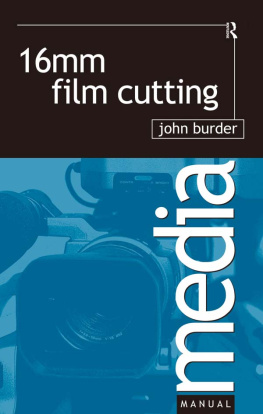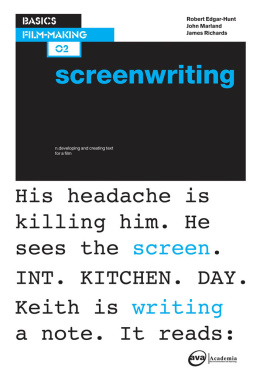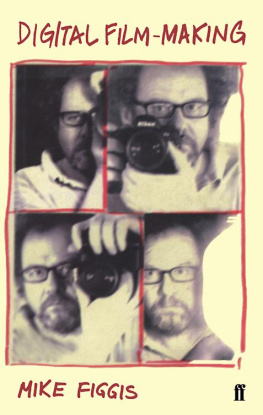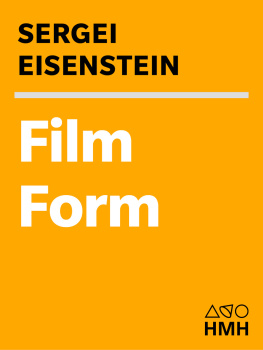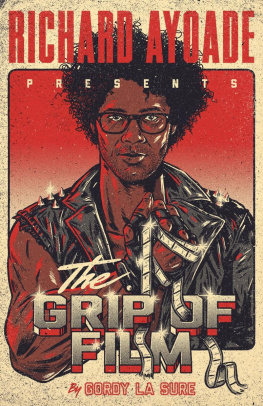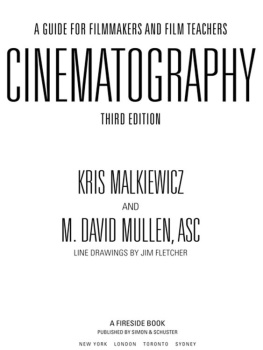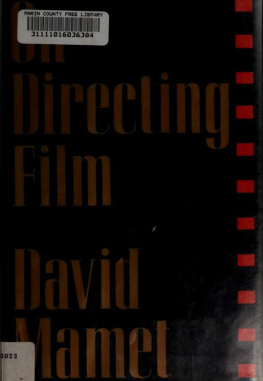BASIC 8ETACAM AND DVCPRO CAMERAWORK
Peter Ward
BASIC FILM TECHNIQUE
Ken Daley
BASIC STUDIO DIRECTING
Rod Fairweather
BASIC TV REPORTING
Ivor Yorke
BASIC TV TECHNOLOGY
Robert Hartwig
CONTINUITY IN FILM AND VIDEO
Avril Rowlands
CREATING SPECIAL EFFECTS FOR TV & VIDEO
Bernard Wilkie
EFFECTIVE TV PRODUCTION
Gerald Millerson
FILM TECHNOLOGY IN POST-PRODUCTION
Dominic Case
GRAMMAR OF THE EDIT
Roy Thompson
GRAMMAR OF THE SHOT
Roy Thompson
LIGHTING FOR VIDEO
Gerald Millerson
LOCAL RADIO JOURNALISM
Paul Chantler and Sim Harris
MOTION PICTURE CAMERA LIGHTING EQUIPMENT
David W. Samuelson
MOTION PICTURE CAMERA DATA
David W Samuelson
MOTION PICTURE CAMERA TECHNIQUES
David W. Samuelson
MOTION PICTURE CAMERA DATA
David W Samuelson
MOTION PICTURE CAMERA TECHNIQUES
David W Samuelson
MULTI-CAMERA CAMERAWORK
Peter Ward
THE PHOTOGRAPHIC LENS
Sidney F. Ray
16MM FILM CUTTING
John Burder
SOUND RECORDING AND REPRODUCTION
Glyn Alkin
SOUND TECHNIQUES FOR VIDEO AND TV
Glyn Alkin
THE USE OF MICROPHONES
Alec Nisbett
VIDEO CAMERA TECHNIQUES
Gerald Millerson
THE VIDEO STUDIO
Alan Bermingham, Michael Talbot-Smith, Ken Angold-Stephens & Ed Boyce
First published 1975 by Routledge
Published 2016 by Routledge
2 Park Square, Milton Park, Abingdon, Oxon OX14 4RN
711 Third Avenue, New York, NY 10017, USA
Routledge is an imprint of the Taylor & Francis Group, an informa business
John Burder 1975
All rights reserved. No part of this book may be reprinted or reproduced or utilised in any form or by any electronic, mechanical, or other means, now known or hereafter invented, including photocopying and recording, or in any information storage or retrieval system, without permission in writing from the publishers.
Notice:
Product or corporate names may be trademarks or registered trademarks, and are used only for identification and explanation without intent to infringe.
Credits and acknowledgments borrowed from other sources and reproduced, with permission, in this textbook appear on appropriate page within text.
ISBN: 9780240508573 (pbk)
British Library Cataloguing in Publication Data
A catalogue record for this book is available from the British Library
Library of Congress Cataloguing in Publication Data
A catalogue record for this book is available from the Library of Congress
Contents
| Feet | at 24 f.p.s | at 25 f.p.s |
| Min. | Sec. | Min. | Sec. |
| 1 | 1.7 | 1.6 |
| 2 | 3.3 | 3.2 |
| 3 | 5.0 | 4.8 |
| 4 | 6.7 | 6.4 |
| 5 | 8.3 | 8.0 |
| 6 | 10.0 | 9.6 |
| 7 | 11.7 | 11.2 |
| 8 | 13.3 | 12.8 |
| 9 | 15.0 | 14.4 |
| 10 | 16.7 | 16.0 |
| 20 | 33.3 | 32.0 |
| 30 | 50.0 | 48.0 |
| 40 | 1 | 6.7 | 1 | 4.0 |
| 50 | 1 | 23.0 | 1 | 20.0 |
| 60 | 1 | 40.0 | 1 | 36.0 |
| 70 | 1 | 57.0 | 1 | 52.0 |
| 80 | 2 | 13.0 | 2 | 8.0 |
| 90 | 2 | 30.0 | 2 | 24.0 |
| 100 | 2 | 47.0 | 2 | 40.0 |
| 200 | 5 | 33.0 | 5 | 20.0 |
| 300 | 8 | 20.0 | 8 |
| 400 | 11 | 6.0 | 10 | 40.0 |
| 500 | 13 | 53.0 | 13 | 20.0 |
| 600 | 16 | 40.0 | 16 |
| 700 | 19 | 30.0 | 18 | 40.0 |
| 800 | 22 | 12.0 | 21 | 20.0 |
| 900 | 25 | 24 |
| 1000 | 27 | 46.0 | 26 | 40.0 |
| 2000 | 55 | 32.0 | 53 | 20.0 |
This is above all a practical book. It is not full of theory, for it is designed to introduce you to the equipment you will find in a professional film cutting room and the basic procedures carried out there. With this book in your pocket, when you are asked to do something you have never done before or are faced with one of the inevitable crises which occur regularly in even the best cutting rooms, you will not be on your own.
In revising the text for this reprint I have brought it up to date so it should continue to be useful in the years ahead. Cutting is a practical job and much must be learned in practice, but when you set foot in a cutting room for the first time you will find the basic advice given in these pages will get you off to an excellent start. If you use this manual in conjunction with my book The Technique of Editing 16mm Films, you will be able to acquire the skills I have used for the last 25 years editing films for television and other outlets. Both books are based on current techniques used by the BBC and by most major television networks.
Cutting is an important and a fascinating job, but before the creative possibilities can be enjoyed basic techniques must be mastered. This book will make life easier for you in those first crucial days in a professional cutting room.
John Burder
The editor is responsible for the film from the time the processed camera original is printed to the time the final edited version of the film is shown to an audience. He combines artistry and technique and gives the film a definite pace. His job starts when the film has been shot and processed. Few films are shot in the order in which scenes occur in the finished film and many scenes are photographed more than once, so the editors first job is to sort out the right scenes and the best takes and assemble them in script order. He then fine cuts the assembly, cutting from scene to scene at the most advantageous points. When the film is completed audiences will hear only one sound track but in the cutting room a number of different tracks must be prepared for music, dialogue and sound effects. The tracks must all be cut to match the edited version of the picture. They can then be mixed together in a dubbing theatre to make the final composite track audiences will hear on the finished film.
Cutting is one of the most important parts of the whole film making process. If a film has been well shot all the efforts of the camera team can be wasted if the editor puts the scenes together inefficiently. On the other hand, a film shot adequately but without any particular distinction can often be improved by skilful cutting.
When the film is shot, film exposed in the camera is sent each day to a laboratory for processing. The laboratory processes the original film and makes a rush print: a copy for cutting purposes. In the U.S.A. these first prints are known as dailies. Elsewhere the term rushes is more widely used. The camera original remains uncut until the final shape and form of each sequence has been determined. Then you can match the camera original to the work print. You can then make further copies from the matched original copies which will be free of the dirt, scratches and joins found in the cutting copy.

